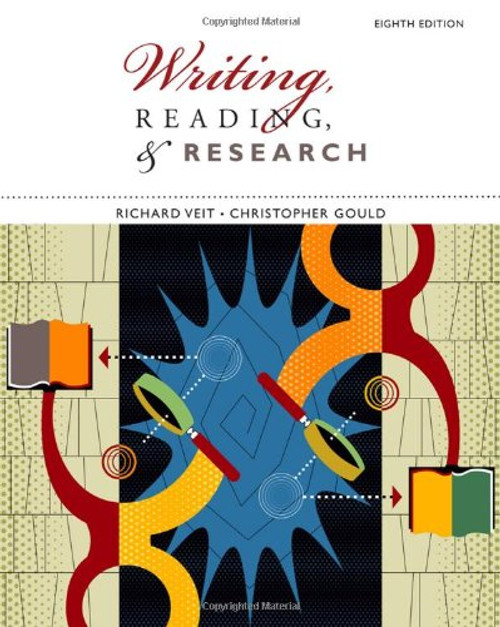Product Overview
Writing Analytically With Readings (Second Edition) combines the authors' best-selling writing guide, Writing Analytically (Sixth Edition), with a reader that teaches users how to have ideas and develop them in an academic setting and beyond. This two-in-one text offers a book-length treatment of analysis, a form of thinking and writing required in virtually all college courses but frequently overshadowed in writing texts by emphasis on argument, expressive writing, or the traditional rhetorical modes. The writing guide is accompanied by a thematically arranged collection of readings and images--material for writers to write about and to use as models and lenses in doing their own writing about the world.
About This Edition
New Features
- The new, completely revised and updated Part I: The Rhetoric features a new introductory chapter.
Chapter 1, Introduction to this Book, to College Writing, and to Thinking About Thinking, shows users how they can take best advantage of the text and its features. For instance, the chapter includes a series of fifteen Short Takes that forecast the modular organization of the text and serve as a reference tool for locating extended topical discussions throughout the text. - New Toolkit chapters.
The extraordinary Writing Analytically heuristics are now divided into two Toolkits of Analytical Methods chapters. The first Toolkit chapter (Chapter 2) equips the student with foundational observation techniques, while the second (Chapter 4) provides activities that allow the student to extend and deepen his or her analysis. - Chapter 3, Analysis.
This chapter focuses on the Five Analytical Moves and now also includes discussion of the counterproductive habits of mind that often supplant effective analysis. There is a new example of the application of the Five Analytical Moves to a Harvard University commencement speech. New Try This exercises are included in Description, Inferring Implications from Observations, and Applying the Five Analytical Moves to a Speech. The chapter has new student writing examples from users of biology, history, and English, and a professional writing from Jane Jacobs's The Death and Life of Great American Cities. - Revised and expanded chapter on reading.
This chapter offers a more developed presentation of How to Read with a new Try This exercise called Writing and Reading with Others. New examples of student writing in this chapter include responses to David Bartholomae's Inventing the University essay. The reading chapter now has a new section on analyzing an audience and specific application of Uncovering Assumptions and Reformulating Binaries heuristics to Christopher Borick's essay, On Political Labels. The chapter also has a new Voices from Across the Curriculum section on critical reading, from a music professor's point of view. - New Chapter 6, Interpretation and Argument.
Combining the previous edition's chapters on interpretation and argument, this single integrated chapter now illustrates how to make plausible claims and take reasonable positions. - Expanded discussion of the thesis statement.
The newly revised Unit II sequences two chapters on the thesis statement so that a student can study what makes a good thesis (Chapter 10) and then study a chapter about how to fix thesis statements (Chapter 11) that could be made more effective. These chapters also contain new examples of student writing. - Integrated Voices From Across the Curriculum sections.
These sections are now integrated throughout the text to more clearly illustrate the connections between writing and the various academic disciplines.
Additional Features
- The text's practical focus emphasizes producing smarter, more perceptive academic writing, as well as shows users that the book's writing and thinking practices are useful in other kinds of writing users do in their lives.
- The authors' exceptional interdisciplinary coverage shows users that while many elements of effective analytical writing are common to all disciplines, there are instances where a discussion of disciplinary differences is clearly called for.
- Each of the six topically organized reading units has a brief introduction that funnels into an equally brief survey of the readings. Each of the individual readings features an introduction as well as a series of concluding thinking and writing tasks designed to encourage analysis ( Things to Do with the Reading ).
- The Things to Do with the Reading exercises encourage readers to tap into the Three Lives of a Reading: as an Object for Analysis (pursuing implication and complication), as a Lens for Viewing Other Material (epistemology: how we come to know things), and as a Model for Imitating (organization). Items listed in Things to Do with the Reading are sometimes labeled as Applications (which involve using the reading as a lens) or as Links (which overtly connect the reading to another reading in the same unit) or as Links across Units.
- Unit-ending For Further Research sections provide a series of print and online leads for readers (and teachers) to pursue if they wish to extend the path of inquiry begun by the unit's reading selections. In addition, Links within the text connect users to other selections within the text that they may find helpful as they complete their assignments.
- The text emphasizes analytical writing as a habit of mind: a way of thinking that is reinforced by a series of specific, reviewer-praised heuristics that teach users to assume an exploratory stance toward ideas and evidence, to treat their ideas as hypotheses to be tested rather than self-evident truths, and to share their thought process with their readers. Engaging discussion of habits of mind illustrates how bad habits can get in the way of good writing and thinking without users even knowing, and how good habits can lead to informed inquiry.
- Each chapter features a variety of Try This exercises and Assignments that get users thinking about writing, testing their new skills with informal writing assignments, and generating ideas for their own papers. These assignments as well as the Try This exercises can be adapted to a wide range of course contents and types of assignments.
See Writing Analytically (Sixth Edition)







